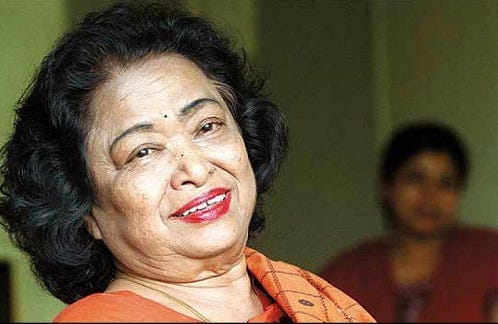Anu’s mother was famous. Newspapers gave her many titles. She disliked most of them, especially the title - ‘human computer’. She solved multiplication problems faster than many computers. Numbers were her best friends. She used to tell children that numbers would start speaking back to you, if you took the time to befriend them. Some people call her ‘the world’s greatest woman mathematician’. To Anu, she was an affectionate, caring and generous soul.
Anu’s mother was Sakuntala Devi.
Sakuntala Devi was the daughter of a circus performer. She never went to school. Math just came to her naturally. She is considered one of the greatest mathematical geniuses that India has ever produced.
Sakuntala Devi’s father was born into a family of priests. As he was growing up, he realised that he had two choices - follow his father’s footsteps and become a priest or, try something new. Since the former did not appeal to him and he was still a young man with a lot of pent up energy, he joined a circus troupe. He learnt to swing from trapezes, perform tricks and kept crowds enthralled. He got married and his wife and kid would move from city to city along with the circus troupe. His daughter (Sakuntala Devi) never had a chance to stay in one place, live in a regular home, go to school or make friends. She certainly never had to study for tests or exams.
One day, when this little girl was three years old, her father tried teaching her a card trick. He saw that she could memorise numbers - even a sequence of 17 digits, with great ease. He saw the early sparks of a prodigy and wanted to make the best of it. So he decided to leave the circus troupe. He took his daughter on a country-wide tour and got her to perform math tricks in front of audiences. That’s how they made a living. Very soon, the name ‘Sakuntala Devi - the child math prodigy’ began to draw large crowds. When the little girl was about six years old, she was sent for by professors at the University of Mysore. She dazzled the senior professors and mathematicians with her incredibly quick computations. By this time, shecould solve even complex algorithms, not just multiplication and division.
Where did she learn all of this?
She learnt it by herself. She loved reading. She loved writing. She loved poring over math books, solved puzzles and even solved high school math problems when she was in kindergarten. She was one of a kind!

Onto our story…..
A few years after her performance at the University of Mysore, her father took her to London and to roadshows throughout Europe. By the time Sakuntala Devi was twenty, she had traveled across Asia, Europe and N.America.
One day, when she was visiting a professor in California, he asked her to calculate the cube root of a very large number. She did it in just a few seconds. The professor thought he would ask her to do something tougher. He asked her to calculate the 7th root of a 23-digit number. He took out his pen to copy down the number and give it to her. While he was still writing down the number, she glanced at it and solved it in 40 seconds. The professor had not even finished copying down the 23-digit number in that time.
This is a story when was asked to perform in front of an audience in another university in the US.
Someone from the audience picked up two random numbers of 13 digits. She was given these numbers on a paper. These were the exact numbers she was given, and she had to multiply them. 7,686,369,774,870 × 2,465,099,745,779. Someone else entered these two numbers into a Univac-1181 (the fastest computer then). She found the answer in 28 seconds. They looked at the computer to check if her answer was correct. The computer had still not finished calculating it. Of course, she was proven correct.
Trivia: Sakuntala Devi repeated this feat many times later. Her name entered the Guiness Book of World Records on 18 June 1980. She was the fastest human computer.
3 things you might like
(a) Sakuntala Devi wrote a book called ‘Figuring: The Joy of Numbers’. You can check it out here. (if you buy it through this link here, we earn a small commission.)
(b) In our most recent podcast episode on football, we discussed this amazing story of an artifact that will soon go for auction. 2 hints - it belongs to a current soccer player and it defined a turning point in recent soccer history. What is this artifact and who does it belong to?
(c ) Want to speak on a podcast this month? We are recording episodes related to wildlife, history, maths, cricket and science. I’m looking forward to chatting with kids (7-15 yrs old). So if you find the idea fun, sign up by clicking ‘I’d like to speak’.




